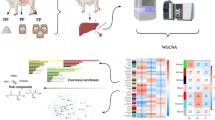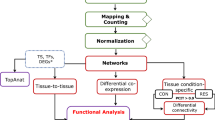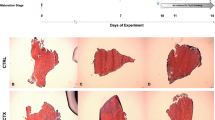Abstract
We examined gene expression changes in liver and skeletal muscle of newborn mice subjected to a maternal low protein (LP) or normal protein (NP) diet during pregnancy, with or without taurine supplementation in the drinking water. LP offspring had a 40% lower birthweight than NP offspring, whereas it was reduced by only 20% with taurine supplementation. Microarray gene expression analysis revealed significant changes in 2012 genes in liver and 967 genes in skeletal muscle of LP offspring. By unknown mechanisms, taurine partially or fully prevented 30 and 46% of these expression changes, respectively. Mitochondrial genes, in particular genes associated with oxidative phosphorylation, were more abundantly changed in LP offspring, with primarily up-regulation in liver but down-regulation in skeletal muscle. In both tissues, citrate synthase activity remained unchanged. Taurine preferentially rescued changes in genes concerned with fatty acid metabolism in liver and with oxidative phoshorylation and tri carboxylic acid (TCA) cycle in skeletal muscle. Conclusion: Gestational protein restriction resulted in lower birthweight associated with significant gene expression changes, which was different in liver and muscle of offspring. However, a major part of the birthweight decrease and the expression changes were prevented by maternal taurine supplementation, implying taurine is a key component in metabolic fetal programming.
Similar content being viewed by others
Log in or create a free account to read this content
Gain free access to this article, as well as selected content from this journal and more on nature.com
or
Abbreviations
- CS:
-
citrate synthase
- LP:
-
low protein
- NP:
-
normal protein
- PGC-1α:
-
peroxisome proliferator-activated receptor γ
- coactivator-1α:
-
Tau
- taurine:
-
TCA, tri carboxylic acid
References
Hales CN, Barker DJ 2001 The thrifty phenotype hypothesis. Br Med Bull 60: 5–20
Vaag A, Jensen CB, Poulsen P, Brons C, Pilgaard K, Grunnet L, Vielwerth S, Alibegovic A 2006 Metabolic aspects of insulin resistance in individuals born small for gestational age. Horm Res 65( suppl 3): 137–143
Jensen CB, Martin-Gronert MS, Storgaard H, Madsbad S, Vaag A, Ozanne SE 2008 Altered PI3-kinase/Akt signalling in skeletal muscle of young men with low birth weight. PLoS One 3: e3738
Ozanne SE, Jensen CB, Tingey KJ, Storgaard H, Madsbad S, Vaag AA 2005 Low birthweight is associated with specific changes in muscle insulin-signalling protein expression. Diabetologia 48: 547–552
Ozanne SE, Jensen CB, Tingey KJ, Martin-Gronert MS, Grunnet L, Brons C, Storgaard H, Vaag AA 2006 Decreased protein levels of key insulin signalling molecules in adipose tissue from young men with a low birthweight: potential link to increased risk of diabetes?. Diabetologia 49: 2993–2999
Brons C, Jensen CB, Storgaard H, Alibegovic A, Jacobsen S, Nilsson E, Astrup A, Quistorff B, Vaag A 2008 Mitochondrial function in skeletal muscle is normal and unrelated to insulin action in young men born with low birth weight. J Clin Endocrinol Metab 93: 3885–3892
Poulsen P, Levin K, Beck-Nielsen H, Vaag A 2002 Age-dependent impact of zygosity and birth weight on insulin secretion and insulin action in twins. Diabetologia 45: 1649–1657
Luo ZC, Fraser WD, Julien P, Deal CL, Audibert F, Smith GN, Xiong X, Walker M 2006 Tracing the origins of “fetal origins” of adult diseases: programming by oxidative stress?. Med Hypotheses 66: 38–44
Martin-Gronert MS, Ozanne SE 2007 Experimental IUGR and later diabetes. J Intern Med 261: 437–452
Shepherd PR, Crowther NJ, Desai M, Hales CN, Ozanne SE 1997 Altered adipocyte properties in the offspring of protein malnourished rats. Br J Nutr 78: 121–129
Fernandez-Twinn DS, Wayman A, Ekizoglou S, Martin MS, Hales CN, Ozanne SE 2005 Maternal protein restriction leads to hyperinsulinemia and reduced insulin-signaling protein expression in 21-mo-old female rat offspring. Am J Physiol Regul Integr Comp Physiol 288: R368–R373
Petry CJ, Dorling MW, Pawlak DB, Ozanne SE, Hales CN 2001 Diabetes in old male offspring of rat dams fed a reduced protein diet. Int J Exp Diabetes Res 2: 139–143
Warskulat U, Flogel U, Jacoby C, Hartwig HG, Thewissen M, Merx MW, Molojavyi A, Heller-Stilb B, Schrader J, Haussinger D 2004 Taurine transporter knockout depletes muscle taurine levels and results in severe skeletal muscle impairment but leaves cardiac function uncompromised. FASEB J 18: 577–579
Bouckenooghe T, Remacle C, Reusens B 2006 Is taurine a functional nutrient?. Curr Opin Clin Nutr Metab Care 9: 728–733
Hansen SH 2001 The role of taurine in diabetes and the development of diabetic complications. Diabetes Metab Res Rev 17: 330–346
Xiao C, Giacca A, Lewis GF 2008 Oral taurine but not N-acetylcysteine ameliorates NEFA-induced impairment in insulin sensitivity and beta cell function in obese and overweight, non-diabetic men. Diabetologia 51: 139–146
Nandhini AT, Thirunavukkarasu V, Anuradha CV 2005 Taurine modifies insulin signaling enzymes in the fructose-fed insulin resistant rats. Diabetes Metab 31: 337–344
Loizzo A, Carta S, Bennardini F, Coinu R, Loizzo S, Guarino I, Seghieri G, Ghirlanda G, Franconi F 2007 Neonatal taurine administration modifies metabolic programming in male mice. Early Hum Dev 83: 693–696
Boujendar S, Reusens B, Merezak S, Ahn MT, Arany E, Hill D, Remacle C 2002 Taurine supplementation to a low protein diet during foetal and early postnatal life restores a normal proliferation and apoptosis of rat pancreatic islets. Diabetologia 45: 856–866
Merezak S, Reusens B, Renard A, Goosse K, Kalbe L, Ahn MT, Tamarit-Rodriguez J, Remacle C 2004 Effect of maternal low-protein diet and taurine on the vulnerability of adult Wistar rat islets to cytokines. Diabetologia 47: 669–675
Svendsen P, Hau J 1994 Handbook of Laboratory Animal Science. CRC Press, Boca Raton, FL
Raffaella C, Francesca B, Italia F, Marina P, Giovanna L, Susanna I 2008 Alterations in hepatic mitochondrial compartment in a model of obesity and insulin resistance. Obesity (Silver Spring) 16: 958–964
Desai M, Crowther NJ, Lucas A, Hales CN 1996 Organ-selective growth in the offspring of protein-restricted mothers. Br J Nutr 76: 591–603
Ozanne SE, Lewis R, Jennings BJ, Hales CN 2004 Early programming of weight gain in mice prevents the induction of obesity by a highly palatable diet. Clin Sci (Lond) 106: 141–145
Morten K, Field P, Ashley N, Williams KA, Harris D, Hartley M, Clark A, Poulton J 2005 Fetal and neonatal exposure to AZT and low-protein diet affects glucose homeostasis: a model with implications for AIDS prevention. Am J Physiol Endocrinol Metab 289: E1115–E1118
Park HK, Jin CJ, Cho YM, Park DJ, Shin CS, Park KS, Kim SY, Cho BY, Lee HK 2004 Changes of mitochondrial DNA content in the male offspring of protein-malnourished rats. Ann N Y Acad Sci 1011: 205–216
Massie HR, Williams TR, DeWolfe LK 1989 Changes in taurine in aging fruit flies and mice. Exp Gerontol 24: 57–65
Reusens B, Dahri S, Snoeck A, Bennis-Taleb N, Remacle C, Hoet JJ 1995 Long term consequences of diabetes and its complications may have a fetal origin: experimental and epidemiological evidences. In: Cowett RM (ed) Diabetes. Raven Press, New York, pp 187–198
Suzuki T, Suzuki T, Wada T, Saigo K, Watanabe K 2001 Novel taurine-containing uridine derivatives and mitochondrial human diseases. Nucleic Acids Res Suppl 1: 257–258
Lane RH, Maclennan NK, Hsu JL, Janke SM, Pham TD 2002 Increased hepatic peroxisome proliferator-activated receptor-gamma coactivator-1 gene expression in a rat model of intrauterine growth retardation and subsequent insulin resistance. Endocrinology 143: 2486–2490
Peterside IE, Selak MA, Simmons RA 2003 Impaired oxidative phosphorylation in hepatic mitochondria in growth-retarded rats. Am J Physiol Endocrinol Metab 285: E1258–E1266
Selak MA, Storey BT, Peterside I, Simmons RA 2003 Impaired oxidative phosphorylation in skeletal muscle of intrauterine growth-retarded rats. Am J Physiol Endocrinol Metab 285: E130–E137
Mootha VK, Lindgren CM, Eriksson KF, Subramanian A, Sihag S, Lehar J, Puigserver P, Carlsson E, Ridderstrale M, Laurila E, Houstis N, Daly MJ, Patterson N, Mesirov JP, Golub TR, Tamayo P, Spiegelman B, Lander ES, Hirschhorn JN, Altshuler D, Groop LC 2003 PGC-1alpha-responsive genes involved in oxidative phosphorylation are coordinately downregulated in human diabetes. Nat Genet 34: 267–273
Patti ME, Butte AJ, Crunkhorn S, Cusi K, Berria R, Kashyap S, Miyazaki Y, Kohane I, Costello M, Saccone R, Landaker EJ, Goldfine AB, Mun E, DeFronzo R, Finlayson J, Kahn CR, Mandarino LJ 2003 Coordinated reduction of genes of oxidative metabolism in humans with insulin resistance and diabetes: potential role of PGC1 and NRF1. Proc Natl Acad Sci U S A 100: 8466–8471
Petersen KF, Befroy D, Dufour S, Dziura J, Ariyan C, Rothman DL, DiPietro L, Cline GW, Shulman GI 2003 Mitochondrial dysfunction in the elderly: possible role in insulin resistance. Science 300: 1140–1142
Roden M 2005 Muscle triglycerides and mitochondrial function: possible mechanisms for the development of type 2 diabetes. Int J Obes (Lond) 2: S111–S115
Holloszy JO 2009 Skeletal muscle “mitochondrial deficiency” does not mediate insulin resistance. Am J Clin Nutr 89: 463S–466S
Ling C, Poulsen P, Carlsson E, Ridderstrale M, Almgren P, Wojtaszewski J, Beck-Nielsen H, Groop L, Vaag A 2004 Multiple environmental and genetic factors influence skeletal muscle PGC-1alpha and PGC-1beta gene expression in twins. J Clin Invest 114: 1518–1526
Boujendar S, Arany E, Hill D, Remacle C, Reusens B 2003 Taurine supplementation of a low protein diet fed to rat dams normalizes the vascularization of the fetal endocrine pancreas. J Nutr 133: 2820–2825
Reusens B, Sparre T, Kalbe L, Bouckenooghe T, Theys N, Kruhoffer M, Orntoft TF, Nerup J, Remacle C 2008 The intrauterine metabolic environment modulates the gene expression pattern in fetal rat islets: prevention by maternal taurine supplementation. Diabetologia 51: 836–845
de Boo HA, Harding JE 2007 Taurine as a marker for foetal wellbeing?. Neonatology 91: 145–154
Uozumi Y, Ito T, Hoshino Y, Mohri T, Maeda M, Takahashi K, Fujio Y, Azuma J 2006 Myogenic differentiation induces taurine transporter in association with taurine-mediated cytoprotection in skeletal muscles. Biochem J 394: 699–706
Warskulat U, Borsch E, Reinehr R, Heller-Stilb B, Monnighoff I, Buchczyk D, Donner M, Flogel U, Kappert G, Soboll S, Beer S, Pfeffer K, Marschall HU, Gabrielsen M, Amiry-Moghaddam M, Ottersen OP, Dienes HP, Haussinger D 2006 Chronic liver disease is triggered by taurine transporter knockout in the mouse. FASEB J 20: 574–576
Parvez S, Tabassum H, Banerjee BD, Raisuddin S 2008 Taurine prevents tamoxifen-induced mitochondrial oxidative damage in mice. Basic Clin Pharmacol Toxicol 102: 382–387
Rees WD, Hay SM, Brown DS, Antipatis C, Palmer RM 2000 Maternal protein deficiency causes hypermethylation of DNA in the livers of rat fetuses. J Nutr 130: 1821–1826
Kwong WY, Miller DJ, Ursell E, Wild AE, Wilkins AP, Osmond C, Anthony FW, Fleming TP 2006 Imprinted gene expression in the rat embryo-fetal axis is altered in response to periconceptional maternal low protein diet. Reproduction 132: 265–277
Hamaguchi T, Azuma J, Schaffer S 1991 Interaction of taurine with methionine: inhibition of myocardial phospholipid methyltransferase. J Cardiovasc Pharmacol 18: 224–230
Jacobsen JG, Smith LH 1968 Biochemistry and physiology of taurine and taurine derivatives. Physiol Rev 48: 424–511
Author information
Authors and Affiliations
Additional information
Supported by grants from the Danish Research Council (Center for Pharmocogenomics), the Danish Council for Strategic Research 2101-05-0030, and the Toyota Foundation. Supported by a grant from the Danish Medical Research Council, grant 271-07-0732 (O.H.M.).
Supplemental digital content is available for this article. Direct URL citations appear in the printed text and are provided in the HTML and PDF versions of this article on the journal's Web site (www.pedresearch.org).
Rights and permissions
About this article
Cite this article
Mortensen, O., Olsen, H., Frandsen, L. et al. Gestational Protein Restriction in Mice Has Pronounced Effects on Gene Expression in Newborn Offspring's Liver and Skeletal Muscle; Protective Effect of Taurine. Pediatr Res 67, 47–53 (2010). https://doi.org/10.1203/PDR.0b013e3181c4735c
Received:
Accepted:
Issue date:
DOI: https://doi.org/10.1203/PDR.0b013e3181c4735c
This article is cited by
-
Rapid changes in Atlantic grey seal milk from birth to weaning – immune factors and indicators of metabolic strain
Scientific Reports (2017)
-
Taurine: the appeal of a safe amino acid for skeletal muscle disorders
Journal of Translational Medicine (2015)
-
Maternal low-protein diet affects myostatin signaling and protein synthesis in skeletal muscle of offspring piglets at weaning stage
European Journal of Nutrition (2015)
-
Perinatal taurine exposure affects adult arterial pressure control
Amino Acids (2014)
-
Lipocalin-2 (Lcn2) expression is mediated by maternal nutrition during the development of the fetal liver
Genes & Nutrition (2014)



